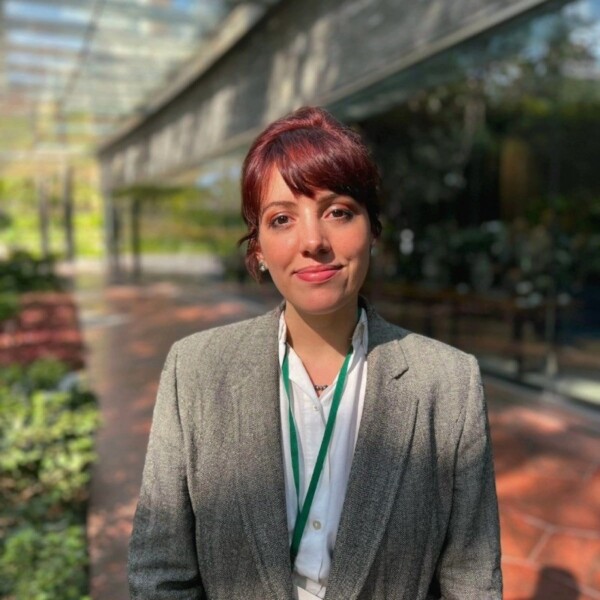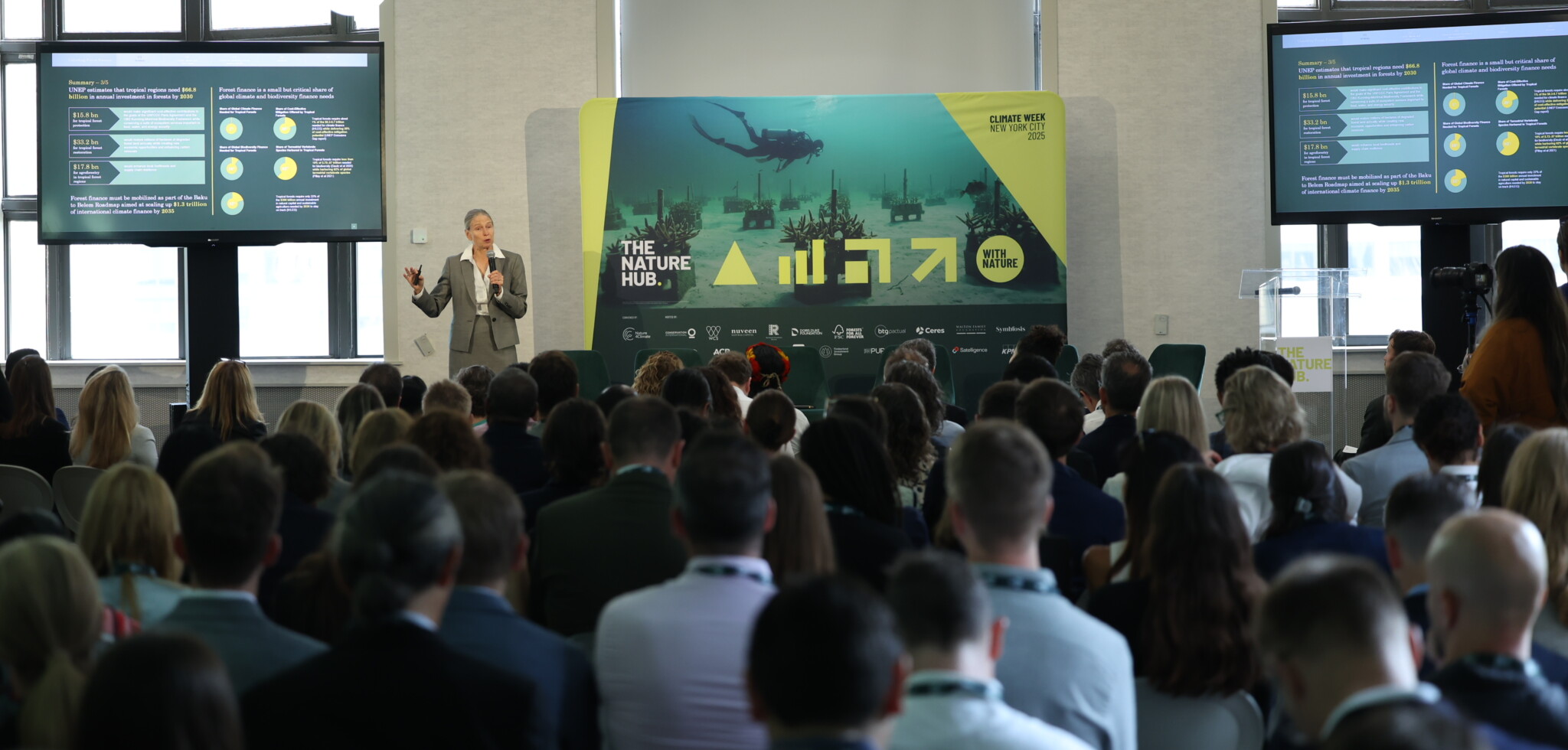
Arin Sang-urai/Nature4Climate
There’s little debate about what stole the spotlight for nature, especially forests, during Climate Week NYC: Brazil’s announcement to invest the first $1 billion in the Tropical Forest Forever Facility (TFFF) raised hopes. But the absence of follow-up commitments from other countries to reach the $25 billion public investment target left a sense that some action was missing from the main stage.
But to truly grasp the vibe of this year’s Climate Week, you had to look beyond the spotlight and into the crowd, where handshakes mattered more than headlines. This year was all about rolling up sleeves and partnering to implement what’s already on the table, making sure COP30 moves from rulebook discussions to real action on the ground.
The UN High-Level Climate Champion for COP30, Dan Ioschpe, summed it up best: “There is a lot that we have to work on already,” he said at the Nature Hub opening plenary. “We don’t need new initiatives. So let’s make this delivery, this implementation cycle, really strong.” His message was quickly echoed by the newly appointed UK Climate Minister, Katie White: “Rather than announcing lots of new plans, we want to work with existing initiatives that can make the biggest impact in the shortest time. We want to draw on the expertise that’s already out there.”
Both made this statement during the launch of a forest finance framework—connecting initiatives like the TFFF with jurisdictional REDD+ carbon markets, debt swaps, and complementary investments in bioeconomy and sustainable supply chains, one of the most complex and also more important moments of the week.
On the simpler side of things, collaboration was the word of the week. Nature-related events were concentrated in “houses,” “hubs,” and collective workshops. It was rare to see anything run in isolation by a single organization or company. The Nature Hub, for example, hosted more than 1,500 people and 350 organizations over three days, loudly declaring that it’s time to invest, adapt, lead, and grow WITH NATURE.
And of course, nature had its own ‘rebranding’ Met Gala moment for the first time—a celebrity’s dinner dubbed the ‘Nat Gala’, where Harrison Ford brought the action back to center stage with a fiery call: “Nature doesn’t need people. People need nature.”
And so it was. At CWNYC, people showed up to point out where collective work can actually work. Here’s what we heard throughout the week:
Read more
Related articles for further reading
The Big News
It wasn’t an easy week. The release of the Planetary Health Check 2025 confirmed that humanity has now breached seven out of nine planetary boundaries, underscoring the urgency of action. The tension surrounding the UN General Assembly—and the broader threats to multilateralism and state-level cooperation—was palpable. Yet, it didn’t stop multilateralism from happening on the ground. According to The Climate Group, host of Climate Week NYC, this year marked the largest edition in the event’s 16-year history, with over 1,000 events, record government participation, and the most extensive lineup of corporate partners to date.
The two major gatherings were bridged by Brazilian President Luiz Inácio Lula da Silva, who convened over 20 countries at UN Headquarters to announce Brazil’s $1 billion anchor investment in the Tropical Forest Forever Facility (TFFF)—a fund expected to play a central role at COP30. The initiative aims to raise $25 billion from sovereign nations, with an additional $100 billion anticipated from private investors.
Brazil’s President Lula framed the investment as leadership by example: “The TFFF is not a charity; it’s an investment in humanity and the planet to counter the threat of climate chaos.”
The announcement quickly resonated in the chamber. Guyana’s Minister of Natural Resources, Vickram Bharrat, responded: “This is not about choosing one model over another. It’s about building a menu of financing options that work together… JREDD+, TFFF, concessional finance—each has its place. Together, they can mobilize the scale of resources the world needs. To pit one against another would be a false choice. Because ambition has never been the problem. What’s been missing is finance at scale.”
Civil society also welcomed the move. John Verdieck, Director of International Climate Policy at The Nature Conservancy, said: “If anyone can achieve a breakthrough on COP, it’s Brazil. Today’s $1bn commitment by President Lula to the Tropical Forest Forever Facility primes the pump of this innovative new financial mechanism, which could ultimately represent Belém’s crowning achievement.”
WWF leaders from Brazil, the UK, Germany, and Norway issued a joint statement: “Brazil’s anchor investment signals a paradigm shift for nature and climate finance by widening the investor base to include governments that have historically been aid recipients, alongside traditional donor countries and private investors. It’s a critical step toward mobilizing large-scale forest finance alongside traditional grant-based assistance.”
Financing forests costs less than ice cream

On the stage: Pepukaye Bardouille (The Bridgetown Initiative); André Aquino (Adviser to the Minister of Environment, Government of Brazil); Irene Velez (Minister of Environment and Sustainable Development, Colombia); Katie White (Parliamentary Under-Secretary of State in the Department for Energy, Security and Net Zero, UK); Vickram Outar Bharrat, (M.P., Minister of Natural Resources, Guyana); Dan Ioschpe (UN Climate Change High-Level Champion for COP30). Photo: Arin Sang-urai/Nature4Climate.
On the 23rd, the Forest and Climate Leaders’ Partnership, COP30 Presidency, and UNEP unveiled a forest finance action framework backed by over 30 governments. The framework lays out six priority solutions to unlock forest finance at scale, aiming to close the US$66.7 billion annual forest finance gap and accelerate progress toward the 2030 goal of halting and reversing forest loss. These priorities piece together the forest finance puzzle, showing the potential ticket size of initiatives like TFFF, JREDD+, forest bioeconomy, redirected supply-chain finance, fiscal policies, and sovereign-debt instruments that reward forest resilience.
“We need to understand the scale of the challenge, and this roadmap shows us that the current shortfall is about $70 billion a year. And while that sounds like a big number, to put it in context—it’s less than the world spends on ice cream”.
UK Climate Minister Katie White.
One of the key voices behind the framework’s analysis, Frances Seymour, Senior Policy Advisor at the Woodwell Climate Research Center, emphasized that this isn’t just a gap. It’s an opportunity. “This number is low—not because it’s the least important, quite the opposite—but because protecting the forests we still have is the most cost-effective option. That $66.8 billion is just 1% of the trillions the international high-level expert group estimates are needed for climate action overall. And yet, tropical forests offer 20% of cost-effective mitigation. It’s a pretty good deal,” she said during the Nature Hub opening. She added: “It’s really clear that forest finance needs to be a part of the Baku-Belém roadmap aimed at mobilizing $1.3 trillion in international climate finance.”
UK Special Representative for Nature Ruth Davis also noted that framing these initiatives as collaborative efforts is not only a rational and systematic way to address the forest finance gap with stakeholders. It also tells a compelling political story. “What feels slightly new to me, and what this productive opportunity might bring, is the potential to transform the political economy. Instead of being a reprimand—‘you must protect at all costs’—it becomes an economic transition that benefits people both politically and economically. There’s also a shift from the theoretical notion that forest loss poses an economic risk to the reality that supply chains now expect losses if the problem isn’t solved. So we’re seeing large parts of the private sector actively seeking enabling environments to fix it.”
Where nature thrives, economies prosper
The Nature Hub hosted the launch of the forest finance roadmap, but that was just one of many solution-driven discussions during the three-day programme. The Brazil Restoration and Bioeconomy Finance Coalition announced that its members have committed to mobilizing a total of US$4.5 billion for forest restoration and bioeconomy projects across the country. This milestone puts the Coalition at 45% of its goal to mobilize at least US$10 billion by 2030. Collectively, these commitments aim to protect or restore 3.65 million hectares of Brazilian forests.
Spearheaded by Capital for Climate and the Brazil NbS Investment Collaborative, in association with Deloitte and a growing set of partners, the COP30 Mobilization has reached 95% of its goal, with at least US$4.75 billion in identified strategic intent to invest in Brazil’s nature-based solutions through 2027. This includes allocations in regenerative agriculture, agroforestry, restoration, and bioeconomy. In companion research, C4C identified US$5.5 billion in capital absorption capacity among 22 scalable NbS developers.
The urgency of forests as natural infrastructure and the challenge of unlocking finance for nature were also central themes throughout the Nature Hub. Forests were highlighted not only as carbon sinks, but as regulators of rainfall, protectors of agriculture, and pillars of resilience. With tipping points approaching, speakers emphasized the need to protect intact forests, halt deforestation, and restore degraded lands as part of a unified strategy.
At the Nature Hub session Act now, manage risk, the debate around “permanence” in carbon markets took center stage. Experts called for moving beyond the binary of “permanent vs impermanent” toward a more practical focus on durability and risk management. While natural climate solutions may face occasional reversals, they offer long-term benefits for carbon, water, biodiversity, and communities. Leading scientists presented evidence that reversal risks are actively managed and improving, challenging outdated narratives that label nature-based solutions as “too risky.” The consensus across sessions was clear: nature-based solutions are credible, durable, and ready-now—and delaying their implementation poses a far greater risk than impermanence itself.
Here are some other standout analyses and announcements from the Hub that are worth checking out:
+ WWF unveiled its new Nature Finance and Investment Strategy, aimed at closing the $900 billion annual nature finance gap. The strategy seeks to mobilize finance at scale, across public and private sectors, using tools like nature markets, debt instruments, public finance, and high-integrity nature-based projects to drive meaningful investment in nature, climate, and community outcomes.Carter Roberts, President & CEO of WWF, emphasized: “It’s not enough to just raise a lot of finance. The finance has to be connected to real impact on the ground… That is one of the things we are going to pursue at WWF: innovative finance that is tied to real, measurable impact on the ground.”
+ The Forest Declaration Assessment and DCF Advisory Group, which includes The Nature Conservancy, WWF, UN Climate High-Level Champions, and Climate Focus.launched a priority action document for DCF finance, featuring NGO-backed recommendations to better align finance and policy sectors in reducing deforestation. The Nature Conservancy also released a new Playbook for Climate Finance, which compiles a decade of breakthroughs into one guide and outlines ten bold approaches to tackle climate change, protect nature, and strengthen communities at scale.
+ Ceres published a new analysis revealing that the five key drivers of nature loss could cost eight global sectors up to $430 billion annually, amounting to a cumulative $2.15 trillion over the next five years if left unaddressed. These findings, published in the report Nature’s Price Tag: The economic cost of nature loss, underscore the urgent need for companies and investors to take action to protect natural ecosystems and avoid escalating financial risks. The report highlights that nature degradation could impose hundreds of billions in annual costs on individual sectors, with the food sector facing the highest impact at $253 billion per year.
+ The Nature Tech Collective debuted the Nature Tech Directory—a free, open-source discovery tool designed to scale nature tech solutions. Built to cut through the noise and connect organizations with the right partners faster, the Directory uses a shared framework co-developed with Impact Labs to categorize solutions across ecosystems—from rainforests to reefs. The prototype currently includes more than 600 organizations and will continue to grow with input from NTC’s 180+ member community.
+ WWF-US launched a new report, Towards Nature Positive for the Ocean, which provides a first-of-its-kind guide specifically designed to support companies operating in marine and coastal environments. It offers practical, science-based pathways to help businesses credibly contribute to the global nature-positive goal: halting and reversing biodiversity loss by 2030, and achieving full recovery by 2050
Inside the Nature Hub – Outstanding Quotes
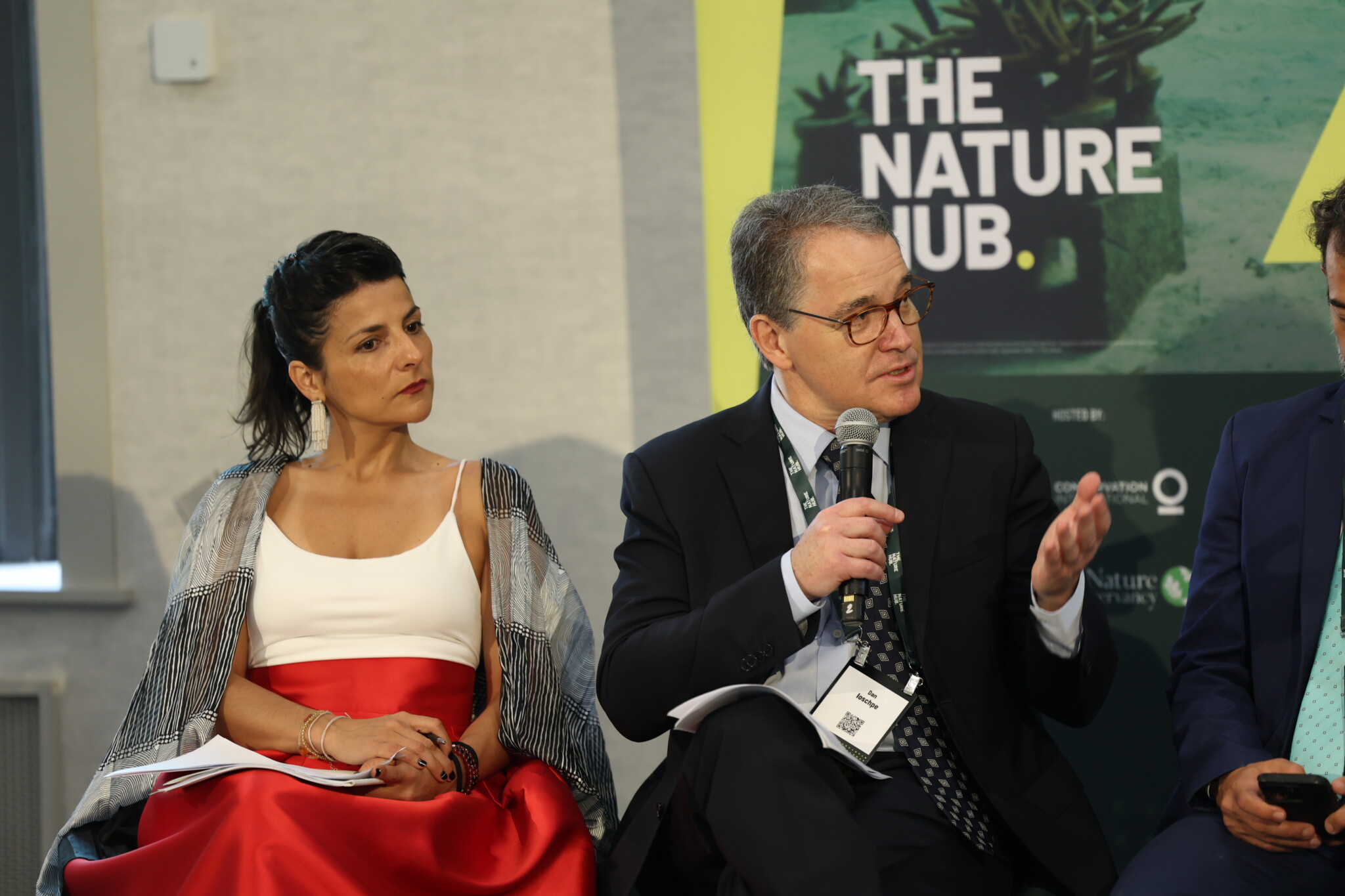
“There are really only two paths forward. Either we pursue socio-economic sustainable development, or we face no economic development at all. That’s the relevance of forests, the importance of financing, and the urgency of maintaining a continuous agenda.” — Dan Ioschpe, Climate Champion, COP30
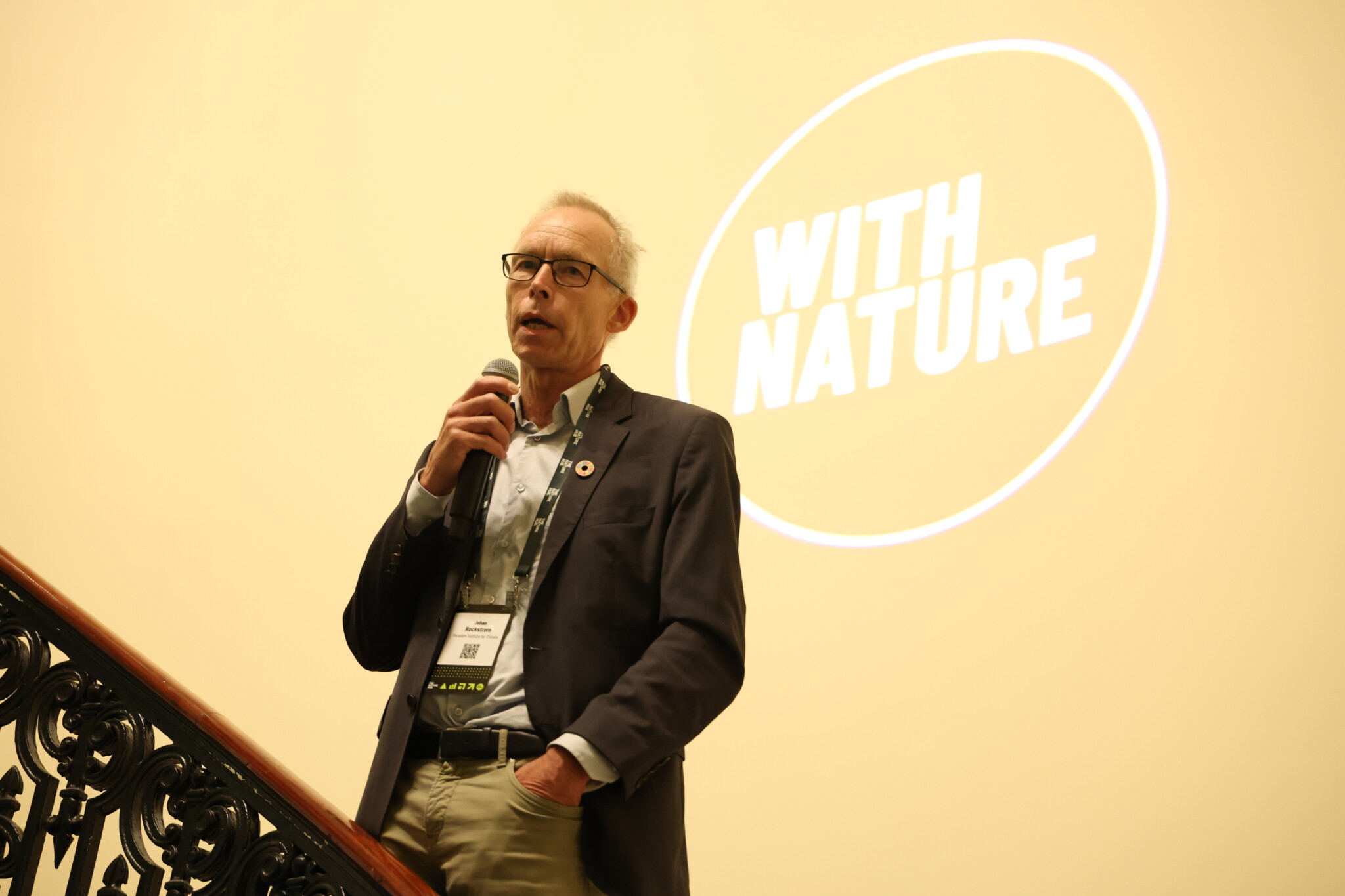
“Within the next five to ten years, we will inevitably breach the 1.5°C limit. That means—with zero uncertainty—more droughts, more floods, more heatwaves, more fires, and more suffering for billions of people around the world. This is now well documented, and we must prepare for that journey. But the bigger question is: How do we return to a manageable future for humanity on Earth? First, we must accelerate the phase-out of fossil fuels. But what can truly enable our return is nature. We’ve reached the point where science tells us that even if we phase out fossil fuels, we will still fail on 1.5°C unless we restore nature within planetary boundaries. We must invest in stewardship of all marine and land-based ecosystems, because they hold the key to resilience. This is the message everyone needs to hear: we are on a dangerous path, but we can turn it around.” — Johan Rockström, Director, Potsdam Institute for Climate Impact Research
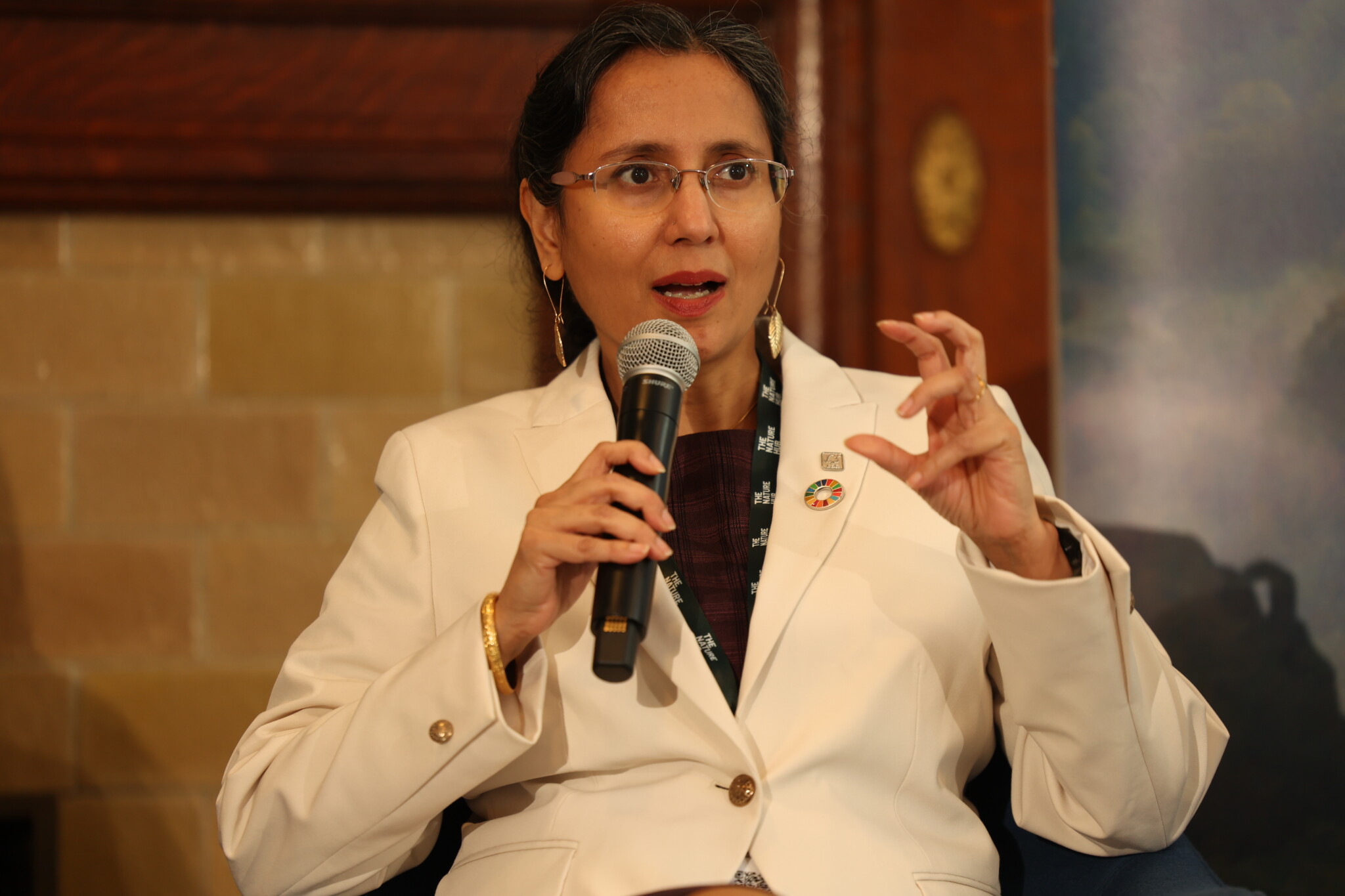
“As we work to drive solutions, the biggest obstacle we face is finance. The way forest finance mechanisms are currently set up, they incentivize short-term, high-risk activities for forests, rather than long-term investment in forest resilience. In 2024, we lost 6.5 million hectares of natural tropical forests, most of it due to wildfires. Last year, just $2 million went into forest-positive activities for sustainable forest management, while $365 billion—one billion for every day of the year—was directed toward activities that put forests at risk.” — Dr. Subhra Bhattacharjee, International Director General, FSC
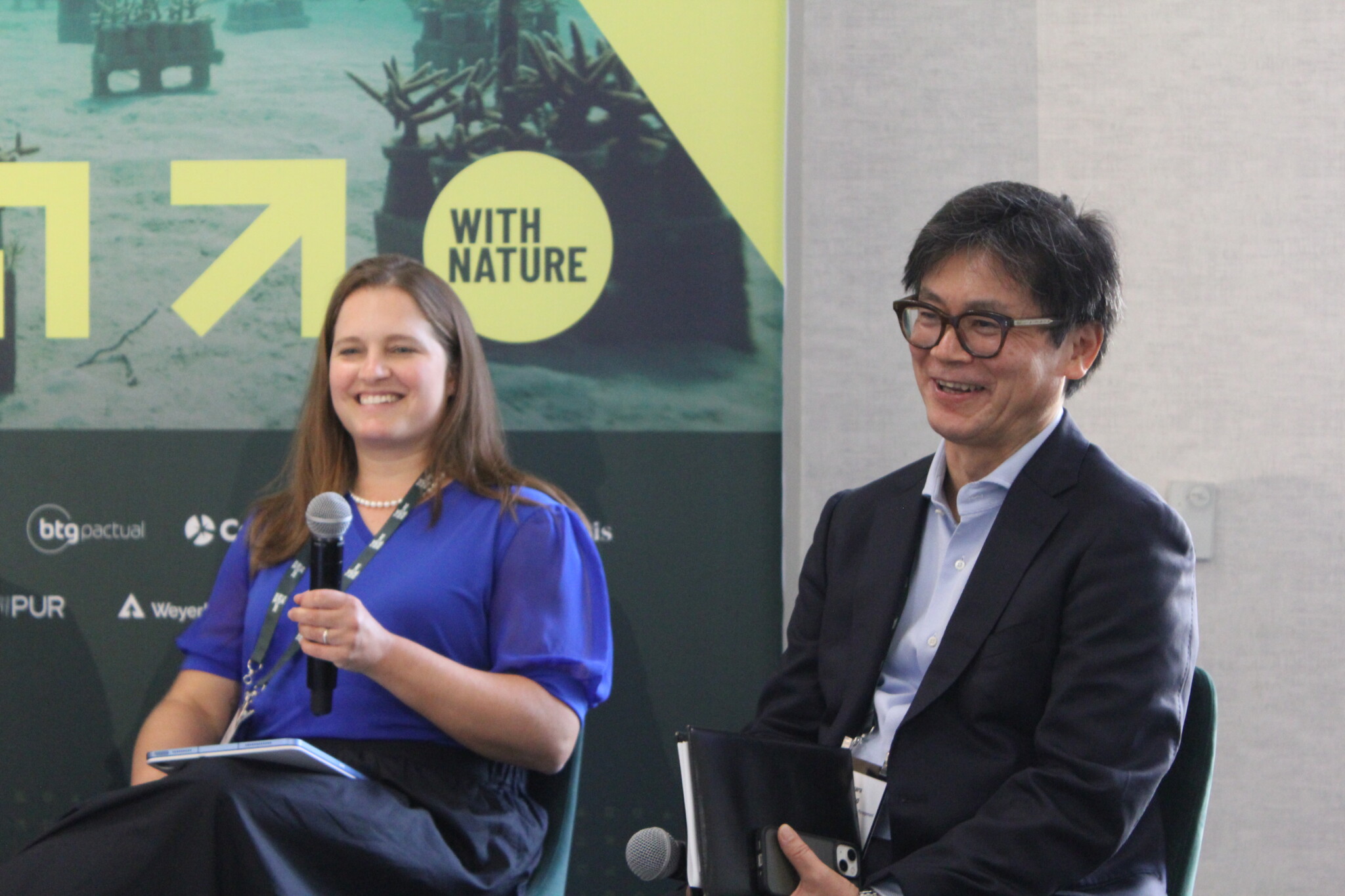
“Companies and investors recognize that nature and biodiversity loss is a systemic financial risk. Ceres’ research shows eight major sectors stand to lose up to $430 billion per year globally from a decline in ecosystem services. The business case for action is clear.” — Meryl Richards, Program Director, Food and Forests at Ceres
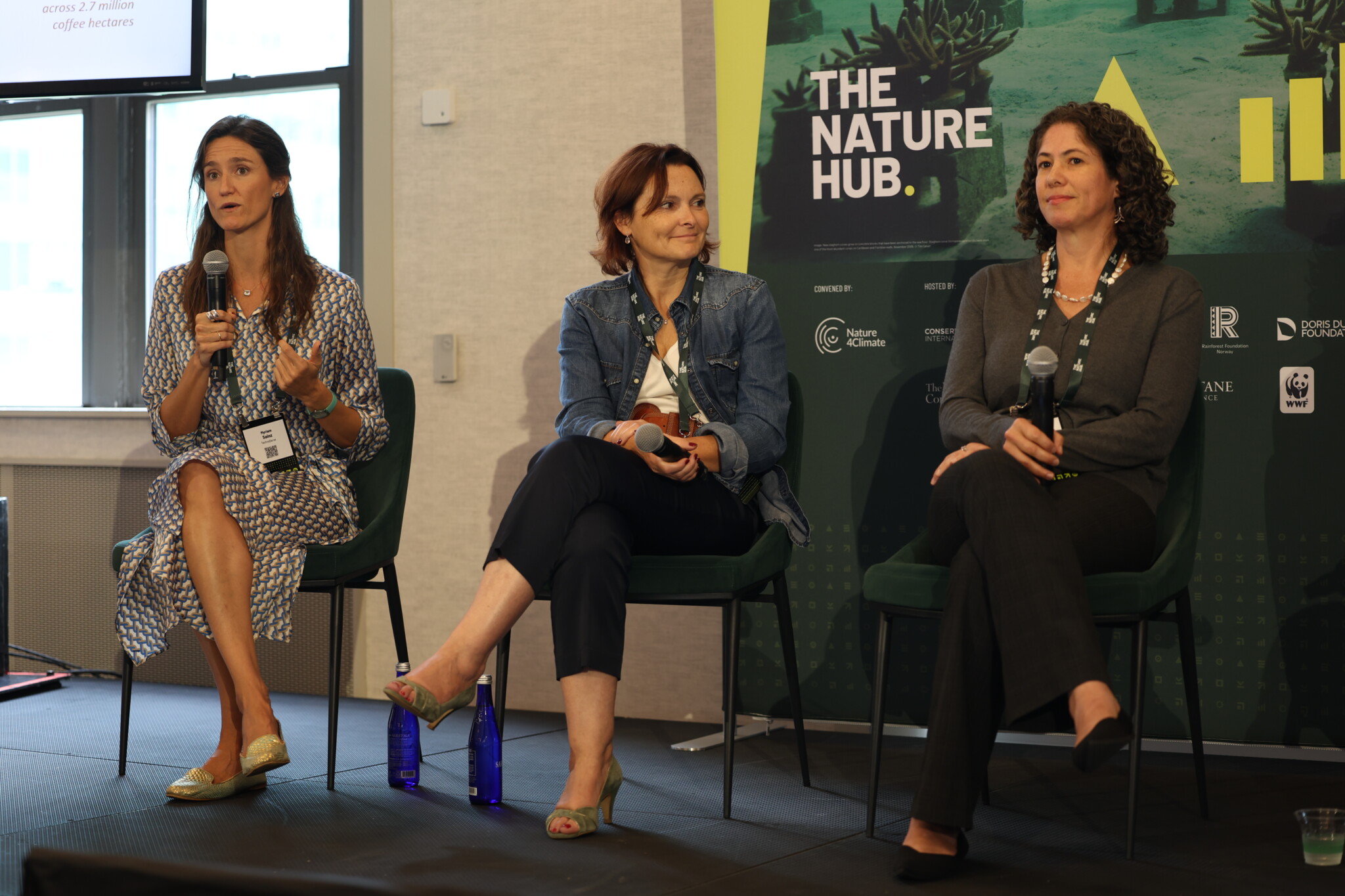
“It is possible to farm differently—and it pays off.” — Myriam Sainz, Senior Director of Strategic Initiatives at TechnoServe
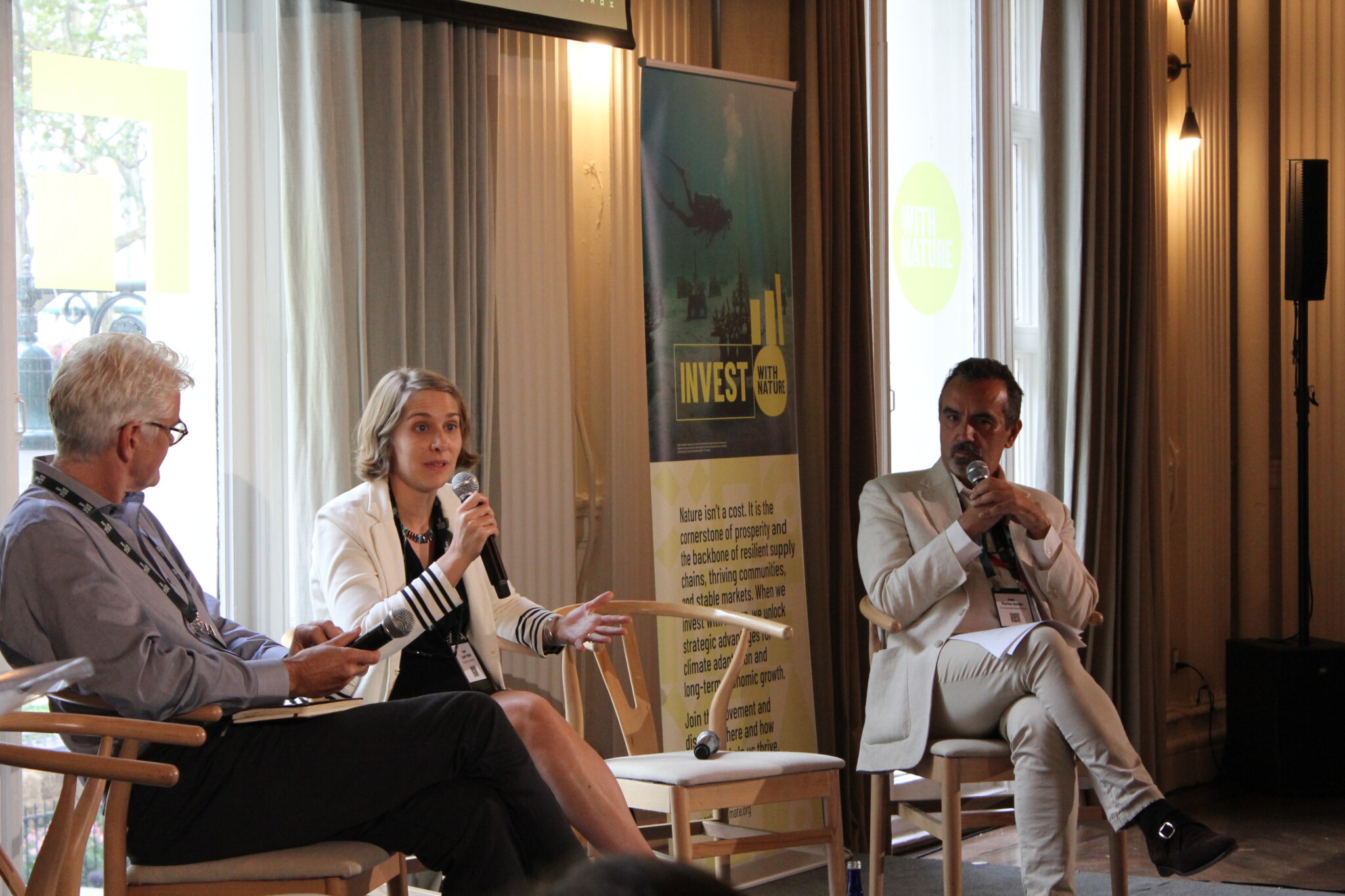
“I would like us to officially retire the word permanence. Permanence is a binary… that just does not reflect the reality of the climate solutions we have on hand today. Natural climate solutions can last 10 years, 20 years, or 1,000 years — there is a range of durability. We really should shift to durability.” Dr Susan Cook-Patton, Lead Reforestation Scientist, The Nature Conservancy
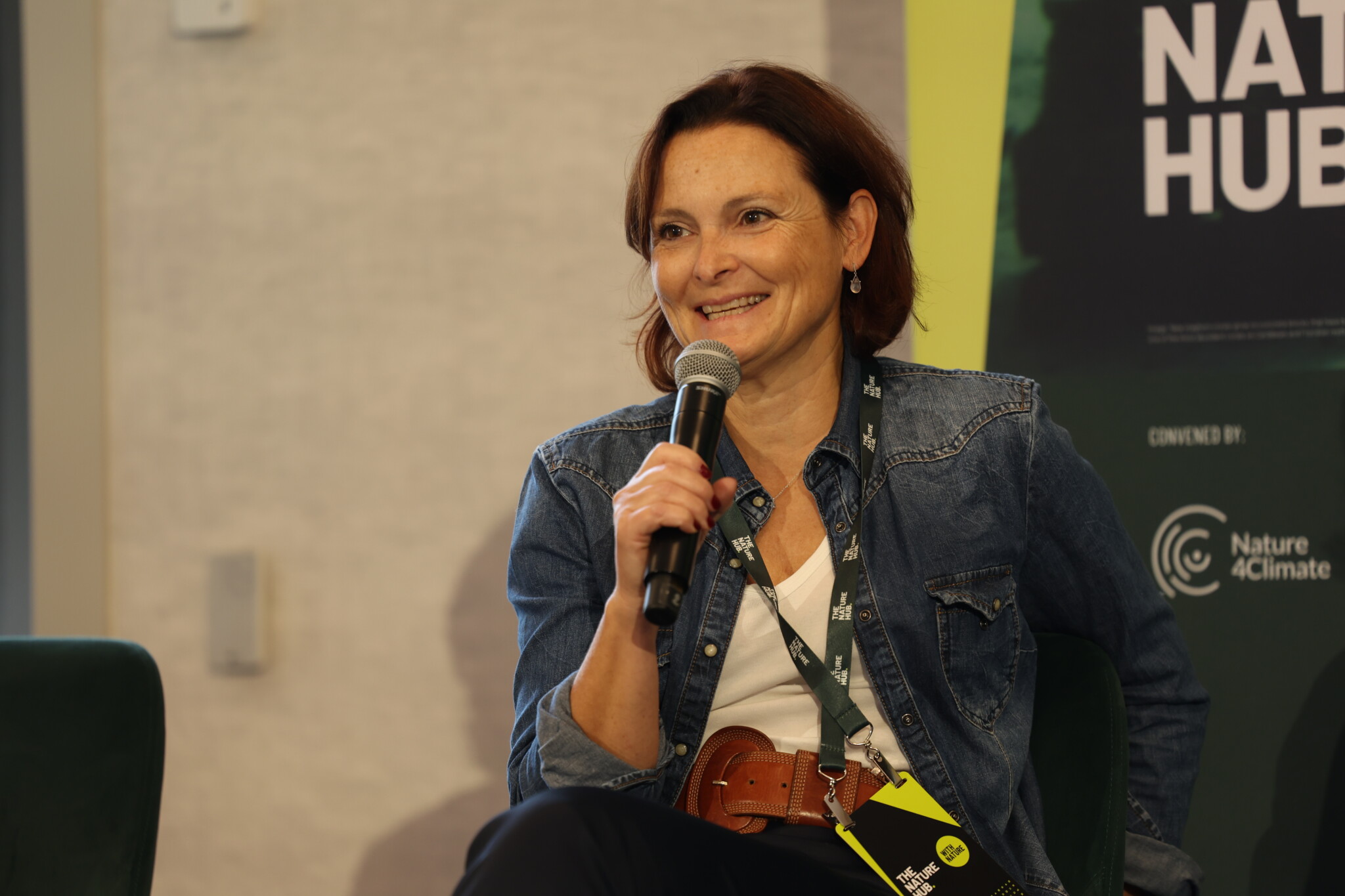
“Regenerative agriculture is low-carbon agriculture that is profitable for farmers and good for nature.” — Julie Reneau, Head of Coffee Sustainability at Nespresso
MORE NEWS:
Governments and philanthropic donors released a new report on the COP26 Forest Tenure Pledge, confirming that the Forest Tenure Funders Group (FTFG) has secured US$1.86 billion in investments—surpassing the original US$1.7 billion commitment. This funding supports Indigenous Peoples and Local Communities (IPLCs) in protecting tropical forests and strengthening land rights. The milestone demonstrates that political will was the missing ingredient for implementation and fuels momentum for a more ambitious “Pledge 2.0,” especially as new ecosystems are considered. However, structural challenges remain: direct funding to IPLC-led organizations dropped from 10.6% in 2023 to 7.6% in 2024, and regional imbalances persist, accordingly with the Global Alliance Territorial Communities.
Rainforest Foundation Norway and Rights and Resources Initiative published the second edition of The State of Funding for Tenure Rights, showing a 46% increase in financial support for IPLCs and forest conservation projects since COP26. However, the report warns that funding peaked in 2021 and has declined each year since, potentially signaling waning momentum. The findings underscore the need for sustained and scaled-up investment to secure Indigenous rights and forest protection.
A global study led by ILEPA and partners analyzed over 700 Indigenous-led climate initiatives worldwide, highlighting Indigenous leadership as a planetary climate stabilizer. Despite their critical role, less than 1% of climate finance currently reaches Indigenous communities. The study calls for at least 25% of climate finance to flow through Indigenous-controlled channels by 2027, alongside secure rights and self-determined solutions. This shift is essential to ensure equity and effectiveness in global climate action.
In a landmark announcement, Ralph Regenvanu, Vanuatu’s Minister for the Environment, introduced the Melanesian Ocean Reserve—the world’s first Indigenous-led, multi-national marine reserve. Spanning six million square kilometers across Vanuatu, Solomon Islands, and Papua New Guinea, the reserve aims to protect ancestral waters and marine ecosystems while supporting culturally aligned, sustainable economic activities. The initiative sets a precedent for Indigenous stewardship in ocean conservation.
Edit Kiss introduced the Capital Continuum framework, a blueprint for transforming high-integrity nature-based carbon projects from fragile concepts into bankable assets. The framework emphasizes climate, biodiversity, and community benefits, aiming to unlock scalable finance for nature-based solutions. It provides a structured pathway for investors to support projects that deliver real impact across multiple dimensions.
A new alliance of universities, private sector leaders, and non-profits launched the VCM+ Coalition, a collaborative effort to raise standards and unlock the full potential of verified carbon markets. With over 50 organizations already on board, the coalition aims to deliver 5 billion tons of CO₂e reductions by 2035 and channel hundreds of billions of dollars into community-based climate solutions and ecosystem restoration. The initiative focuses on credibility, equity, and innovation to close gaps in today’s carbon markets.
The Science Based Targets Network (SBTN) launched Accelerated Pathways to help companies take credible action on nature faster. This modular approach allows businesses to begin with focused scopes—by unit, environmental realm, or value chain segment—without lowering the bar. The goal is to enable early action, prove impact, and scale toward comprehensive nature targets. The initiative supports companies in aligning with science-based goals while responding to urgent environmental needs.
The Nature Risk 2025 report by Risilience reveals that only 36% of firms have a nature plan, and many still struggle to quantify nature-related risks. The report calls for embedding nature into enterprise risk management alongside climate, highlighting the growing urgency for businesses to address biodiversity loss and ecosystem degradation as core strategic risks.
The first TNFD Status Report highlights significant uptake of nature-related reporting since the release of its recommendations in September 2023. Over 620 organizations across 50+ countries, representing US$20 trillion in AUM, have committed to TNFD-aligned reporting. The report shows that 63% of surveyed companies view nature-related issues as equally or more significant than climate-related ones, and 78% have integrated climate and nature disclosures. Investor demand for specific nature-related standards is also rising, with 77% calling for further development based on TNFD.
Vox Capital previewed a new fund that aims to accelerate the agriculture transition in Brazil across the soy and cattle sectors in the Cerrado and Amazon. The fund will be launched at COP30 under the title of Catalytic Capital for Agricultural Transition (CCAT) Fund and is designed as a private debt facility with Vox Capital also providing concessional capital. The fund will be supporting proven financing products and co-investing with supply chain companies to help them scale finance and incentives for farmers, while achieving their deforestation and conversion-free (DCF) commitments.
